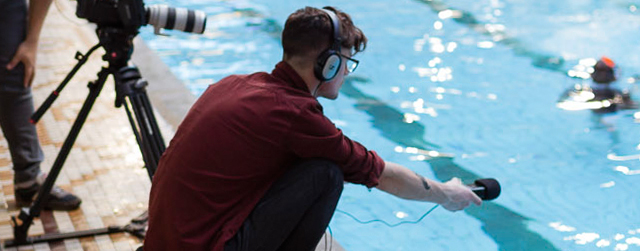
The Beauty of Sound
Paul Broadie
The Importance of Sound in Video
With incredible picture quality and choice becoming quickly more accessible and vast, it’s unsurprising that many film makers focus most of their attention to the visual quality of their work. But unless you’re making a silent movie, sound is pretty important, and the quality of the sound has a big influence on the final product. With this in mind, Manto Films have been aiming to pay more attention to sound on every shoot we do. Often redoing takes so that we can do a version where the microphones have the priority over the cameras. Though sometimes there are limitations on set, other noises in the environment and tight time schedules, so some sound design is required later on.
We’ve become particularly fond of recording and creating “macro sounds” to be used with the the extreme close up footage that we often go for. An example of this was when we filmed a wood carver working in his workshop. Just like getting your lighting and composition right, we had to spend the time to get the sounds just right. Fortunately on this shoot we were in a quiet area in the Yorkshire country side, and so it was easy to capture specific sounds. A process that requires some patience, but when done right it completely isolates what is happening on screen and gets your full attention. It’s this kinda of attention to detail that when compiled with good visuals, makes great film.
Many cinematic productions use sound intelligently, but one that comes to mind is Saving Private Ryan. During the battle scene on Omaha Beach, there is no music, and all the sounds make you feel like you’re there on the battle field. The sound designers wanted to create as realistic sound experience as possible, with the sound of bullets flying past your head, derby falling around you, distant sounds of your comrades shouting and screaming, this combined with shaky camera gives a sense of fear and desperation.
Apparently, to create the most convincing sound of bullets piercing the flesh of the soldiers, the sound specialists fired live bullets in the carcasses of cows. Also, this film was innovative for creating the “shell shock” isolation sounds, where Tom Hanks’ character is in a haze and the surrounding sounds becoming hazy and unclear. A technique that now gets used frequently in not only Hollywood productions, but all sorts of films. Arguably it’s a bit overused now and so you don’t appreciate this technique like you would have when it was first introduced.
“Music and sound effects are simple devices to sharpen a visual statement, render a scene appropriately complex, and provide, or add to, the impact or aesthetic energy of a scene.” – Adler 1981
This statement sums up this battle scene perfectly, the visuals and the sound together create this terrifying simulation of war. Some World War II veterans stated that the film was the most realistic depiction of combat they had ever seen. The film was so realistic that combat veterans of D-Day and Vietnam left theatres rather than finish watching the opening scene depicting the Normandy invasion. It’s interesting how sound can be used to recreate sensations and feelings, transporting you to a memory, arguably more so than visuals.
Less realistic films, like modern day CGI blockbusters, use sound design to create something that feels realistic, even if it is portraying something completely out of this world. This documentary shows how creative the Sound Design team for the Transformers movies were. Using electric guitars, dry ice, and various explosives in different environments or containers to create a library of interesting and convincing sound effects.
We haven’t produced CGI blockbusters ourselves, but we have worked on animations where you don’t have live footage to relate a sound to. Instead you need to use your imagination to create the correct sound for whatever is required. We once did an animation of a thought bubble character, and this thought bubble would interact with various scenarios. In one segment the thought bubble jumps onto a large pile of coins, so we needed a sound effect of a soft, light object landing onto a pile of coins. So we made quite literally made that happen, and used a small orange in place for a thought bubble.
We believe film and video production is all about capturing, designing and editing both visual and sound, and amalgamating these together into a final composition. If either the visuals or sounds are impaired then it effects the other; but if both are produced correctly, then you’ve got the right set up for telling your story through film.